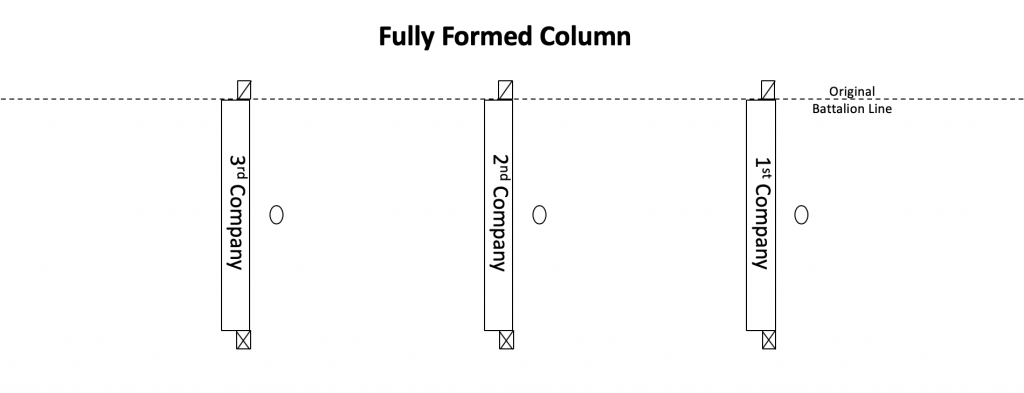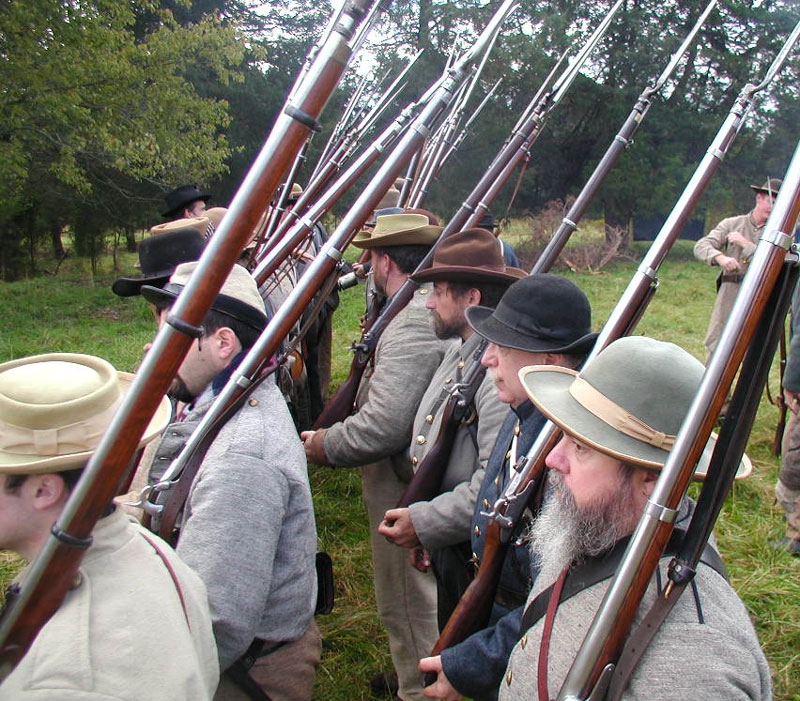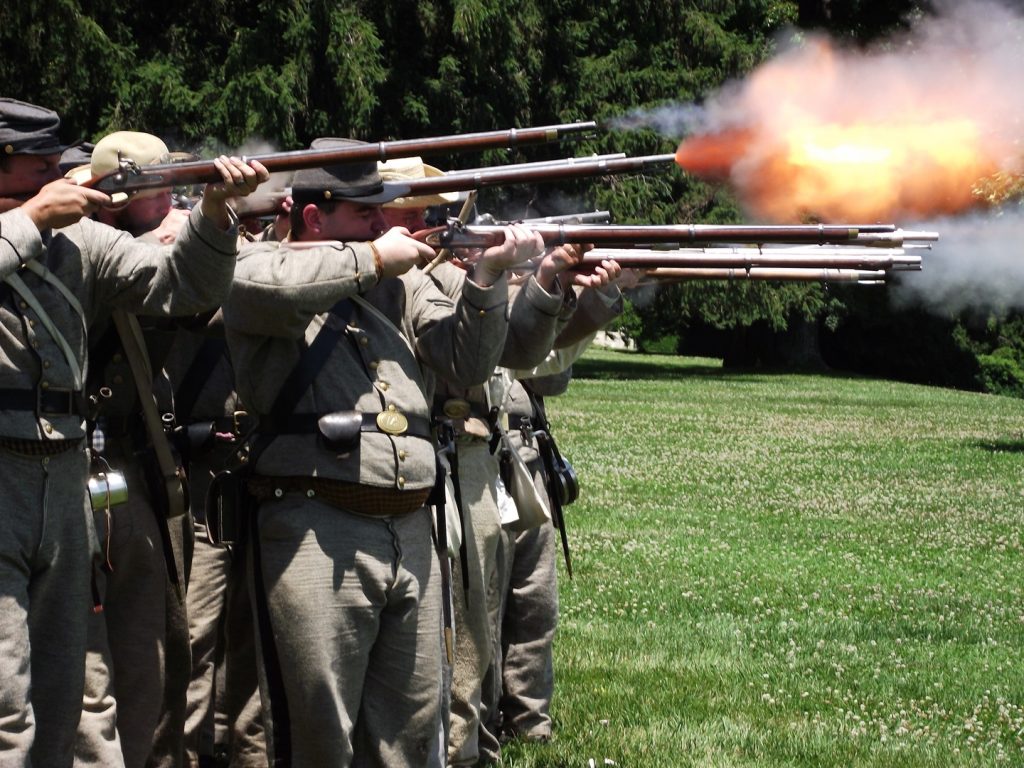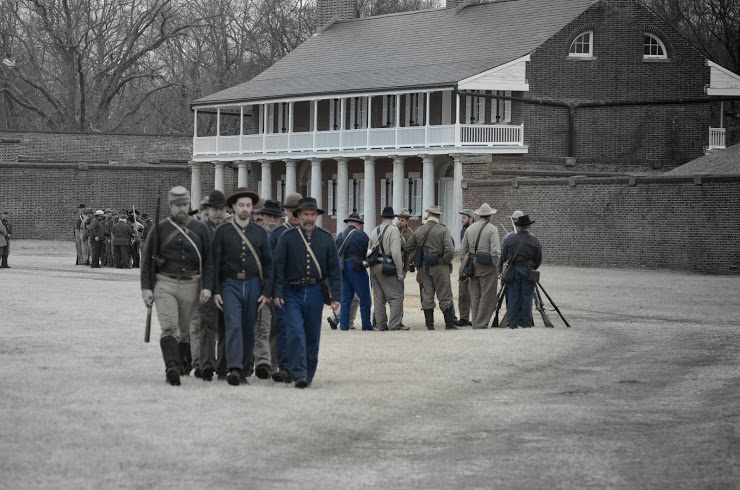By Austin Williams, 5th VA Co. A
Before a reenactor infantry battalion can be marched the drill field or battlefield, its various component companies must first be formed into a cohesive single unit. Soldiers during the Civil War likely formed their battalions thousands of times over the course of their service, rendering it a habitual action after only a short time. However, reenacting battalions are frequently comprised of companies with little experience drilling together as a single battalion. It is therefore important for reenactors, particularly those filling the roles of company officers and non-commissioned officers, to understand the principles of forming the battalion and their role in this foundational evolution before advancing onto other evolutions of the infantry battalion.
Unfortunately, several period drill manuals say little about how a battalion is formed. Hardee’s drill manual, used by so many reenactor units, opens its School of the Battalion by stating only:
“The color-company will generally be designated as the directing company. That, as soon as formed, will be placed on the direction the colonel may have determined for the line of battle. The other companies will form on it, to the right and left, on the principles of successive formations which will be herein prescribed.”(1)
Thankfully, as with several other maneuvers so basic that other period manuals don’t cover them in detail, Major William Gilham’s 1861 manual for volunteers and militia goes through this maneuver step by step. Gilham’s description is consistent with Hardee’s instructions to follow the principles of successive formations, suggesting that Gilham is a solid foundation upon which to build our understanding of how to form a battalion regardless of the specific drill manual being used by a battalion. The following is derived from Gilham’s manual unless specified otherwise. (2)
Prior to the formation of the battalion, company officers and NCOs form their companies at their company’s individual company streets. Upon the adjutant’s call, each company commander will march his company to the location designated to form the battalion. The color company should be the first company formed, with the color guard on the company’s left flank marking the center of the desired battalion line. Battalion officers will place two markers to designate where they wish the color company to form, with one marker in front of the right corporal of the color guard and the other approximately where the right flank of the color company would rest, facing towards the first marker. The color company is halted by its captain three paces behind these markers and then dressed to the line of markers by its captain with the command Left—DRESS. Note that the captain stands on the left flank of his company for this order, which will be discussed in further detail later in this article. Gilham’s has no further instructions for the color company, but Hardee’s instruction to follow the principles of successive formations suggests that the captain of the color company (and those which follow) should order Support—ARMS after the company that forms after it is properly dressed.
 Figure 1. Immediately following the order Left—DRESS by the captain of the color company. (3)
Figure 1. Immediately following the order Left—DRESS by the captain of the color company. (3)
The company to the left of the colors forms next. Its captain marches the company to the left of the color company and three paces behind their line. The company’s second sergeant is then placed in line with, and facing towards, the original two markers, roughly in front of the three left files of his company. The battalion Adjutant assists with aligning the second sergeant. The captain then places himself to the left of the color company and orders Right—DRESS. As mentioned above, after this captain commands Front, the captain of the color company orders Support—ARMS for his company.
 Figure 2. Just prior to the order Right—DRESS by the captain of the company to the left of the colors.
Figure 2. Just prior to the order Right—DRESS by the captain of the company to the left of the colors.
Of note, the captain of the color company stood on the left of his company to order them to dress to the left, while the captain of the company to the left of the color company stands on the right of his company to dress them to the right. These two captains must therefore occupy the same captain’s interval, since the captain of the color company will return to his usual spot on the right of his company only once the battalion is fully formed. Gilham does not address this issue. The solution, as laid out in Dominic Dal Bello’s excellent modern manual Parade, Inspection, and Basic Evolutions of the Infantry Battalion, is for the captain of the color company to move to the rear rank of the captain’s interval (to the position which would normally be a first sergeant) when the company to his left arrives at the battalion front. (4) Additionally, despite widespread and incorrect reenactor practice, the color company’s second sergeant is not posted on the left flank of the color company. His proper post is in the rank of file closers.
 Figure 3. Just prior to the order Left—DRESS by the captain of the company to the left of the colors.
Figure 3. Just prior to the order Left—DRESS by the captain of the company to the left of the colors.
Next, the company to the right of the color company forms. Its captain marches his company to the right of the color company, halting them three paces to the rear of the forming battalion line. The company’s first sergeant then joins the line of markers, facing towards the colors and roughly aligned with the right three files of the company. The battalion Sergeant Major assists with aligning the first sergeant. The company’s captain then places himself to the right of the color company and orders Left—DRESS, aligning his company into the battalion front. After the captain of this company orders Front, the captain of the company to the left of the color company orders Support—ARMS.
All subsequent companies continue to form using these principles, one company at a time and alternating to the left and right of the color company. Companies to the left of the colors place their second sergeant out as a guide and their captains stand on the right side of their companies. Companies to the right of the colors send their first sergeant out as a guide and their captains stand to the left of their company, in the captain’s interval of the company to their left. All guides face towards the colors. After the following company has properly dressed, the preceding company takes the position of Support—ARMS.
 Figure 4. A battalion with all its companies in position, but with guides still in place.
Figure 4. A battalion with all its companies in position, but with guides still in place.
Once the battalion is fully formed, the battalion adjutant commands Guides—POSTS, upon which all sergeants who are posted as guides will pass through the nearest captain’s interval to reach their usual spot behind their captain for first sergeants or in the rank of file closers for second sergeants (with the exception of the left flank company of the battalion, whose second sergeant stands on the left flank of the battalion as the left general guide of the battalion). Captains of companies to the right of the colors, including the captain of the color company, will move to their usual spots at the right of their companies, in front of their first sergeants. The battalion is now formed and may be inspected, drilled, or marched to battle.
 Figure 5. A fully formed battalion. As this battalion has only three companies, the second sergeant of the 3rd Company serves as the left general guide of the battalion.
Figure 5. A fully formed battalion. As this battalion has only three companies, the second sergeant of the 3rd Company serves as the left general guide of the battalion.
Footnotes
(1) Hardee, William J. Hardee’s Rife and Infantry Tactics for the Instruction, Exercises and Maneuvers of Riflemen and Light Infantry. New York: J.O. Kane Publisher, 1862. Title Fourth – School of the Battalion, Section 2.
(2) Gilham, William. Manual of Instruction for the Volunteers and Militia of the United States. Philadelphia: Charles Desilver, 1861. Article VI, Section 297.
(3) Please note that only three companies are shown in these diagrams for the sake of simplicity. If this battalion consisted of only three companies, the first company, rather than the second, would properly be the color company.
(4) Dal Bello, Dominic J. Parade, Inspection and Basic Evolutions of the Infantry Battalion. Santa Barbara: Army of the Pacific Press, 1998. Page 62.











 Figure 1. Just after the order MARCH, with each company captain placed where they estimate their left flank will lie and the second sergeant covering the left flank of the company.
Figure 1. Just after the order MARCH, with each company captain placed where they estimate their left flank will lie and the second sergeant covering the left flank of the company. Figure 2. Just prior to Left—DRESS, with the left flank of each company three paces from the perpendicular and the second sergeant with his left arm lightly against the captain’s chest.
Figure 2. Just prior to Left—DRESS, with the left flank of each company three paces from the perpendicular and the second sergeant with his left arm lightly against the captain’s chest.  Figure 3. A completed column of companies, right in front.
Figure 3. A completed column of companies, right in front. Figure 4. Just after breaking files to the rear, each captain next to the last file of the preceding company and the first sergeants preparing to lead each company by the flank to the rear.
Figure 4. Just after breaking files to the rear, each captain next to the last file of the preceding company and the first sergeants preparing to lead each company by the flank to the rear.  Figure 5. Each company marching to by the right flank, with each file wheeling at the same point as the first two files and proceeding to the rear, led by the first sergeant.
Figure 5. Each company marching to by the right flank, with each file wheeling at the same point as the first two files and proceeding to the rear, led by the first sergeant.  Figure 6. Just prior to Left—DRESS, with each company faced to the front and each second sergeant aligned with his captain.
Figure 6. Just prior to Left—DRESS, with each company faced to the front and each second sergeant aligned with his captain.  Figure 7. A completed column of companies, right in front. Note the column’s relationship with the original battalion line and how this might affect whether a commander wishes to form column by breaking to the right or by breaking to the rear.
Figure 7. A completed column of companies, right in front. Note the column’s relationship with the original battalion line and how this might affect whether a commander wishes to form column by breaking to the right or by breaking to the rear. 
 Figure 1. Just after the order MARCH, with each company wheeling in the direction of the line established by the second sergeants and the first sergeant of the first company.
Figure 1. Just after the order MARCH, with each company wheeling in the direction of the line established by the second sergeants and the first sergeant of the first company.  Figure 2. Just prior to the command Right—DRESS, with captains next to the leftmost man of the company to their right.
Figure 2. Just prior to the command Right—DRESS, with captains next to the leftmost man of the company to their right.  Figure 3. Just after the companies left half wheel and begin marching forward. First company has established the battalion line as designated by the markers.
Figure 3. Just after the companies left half wheel and begin marching forward. First company has established the battalion line as designated by the markers. Figure 4. Just before the second company dresses to the right. Simultaneously, the third company is just about to execute a right turn, having cleared the flank of the second company.
Figure 4. Just before the second company dresses to the right. Simultaneously, the third company is just about to execute a right turn, having cleared the flank of the second company. Figure 5. Just after first company has dressed along the desired battalion line. Note the subsequent companies continuing to march forward.
Figure 5. Just after first company has dressed along the desired battalion line. Note the subsequent companies continuing to march forward. Figure 6. Just before second company dresses along the desired battalion line. Note third company in position to conduct their right turn.
Figure 6. Just before second company dresses along the desired battalion line. Note third company in position to conduct their right turn.


 Figure 3. Just prior to the order Left—DRESS by the captain of the company to the left of the colors.
Figure 3. Just prior to the order Left—DRESS by the captain of the company to the left of the colors. Figure 4. A battalion with all its companies in position, but with guides still in place.
Figure 4. A battalion with all its companies in position, but with guides still in place. Figure 5. A fully formed battalion. As this battalion has only three companies, the second sergeant of the 3rd Company serves as the left general guide of the battalion.
Figure 5. A fully formed battalion. As this battalion has only three companies, the second sergeant of the 3rd Company serves as the left general guide of the battalion.


